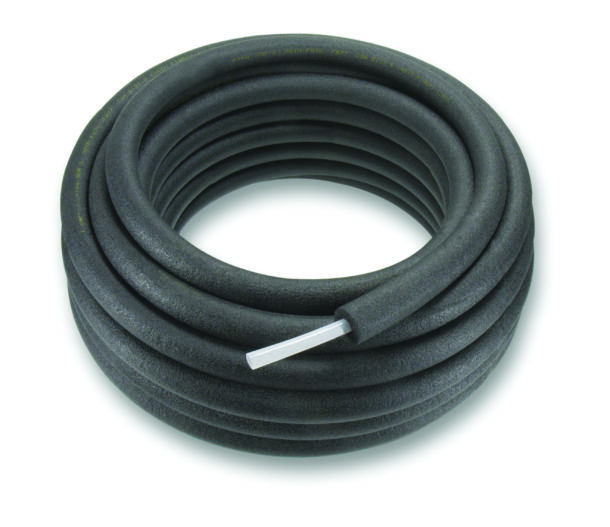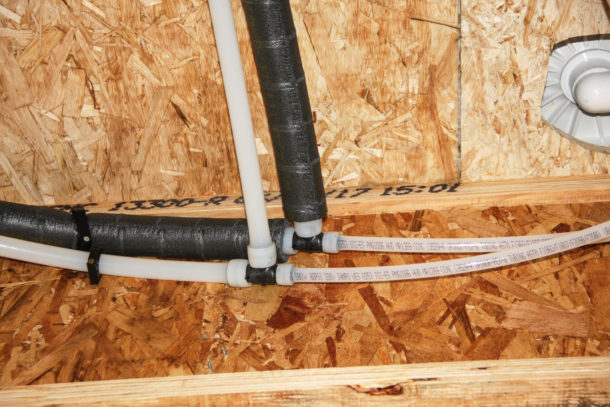With energy-efficiency and water conservation at top of mind for savvy consumers and forward-thinking homebuilders, it is important for plumbing installers to have a piping solution that meets energy codes but can also install quickly and effectively.
Enter pre-insulated PEX pipe.
With PEX pipe now installed in more new-home construction than copper and CPVC combined, it has become the standard for residential plumbing systems due to its flexibility for faster installs and fewer connections along with extreme corrosion and freeze resistance.
 Couple those benefits with a piping system that already has the insulation on the piping, and you have a smart solution that brings efficiency and ease to your installs without the need to add insulation after the pipe installation.
Couple those benefits with a piping system that already has the insulation on the piping, and you have a smart solution that brings efficiency and ease to your installs without the need to add insulation after the pipe installation.
Pre-insulated PEX is available in pipe sizes up to 2″ with insulation thicknesses from ½” to 2″. This offering can meet various energy code requirements for any residential plumbing application. And because the pipe is available in long coil lengths up to 100 feet, it helps to eliminate unnecessary connections, speed installs and limit potential leak-point liability.
The lightweight pipe is both strong and durable, but very easy to move around the jobsite, helping to support worker safety and reduce liability from injuries. And the PEX joining system is fast and easy to learn (see below for a brief overview of each method).
For an expansion connection, simply slide an expansion ring over the end of the pipe and expand the pipe and ring with an expansion tool. Then, insert a larger-diameter fitting. As the pipe and ring shrink back down, it creates a solid, strong connection.
One of the biggest benefits of the expansion system is that it cannot be dry fit. It is fast to learn, easy to install and is the only PEX connection system that actually gets stronger over time. This is because it maximizes the “shape memory” of PEX, which means the pipe always wants to return to its original shape. Plus, the system is approved for direct burial in soil and concrete.

With crimp, you slide a copper ring onto the pipe, insert a smaller-diameter fitting and slide the ring back toward the end of the pipe before compressing the ring onto the pipe. While this is an inexpensive, fast and easy-to-learn technique, crimping works against the “shape memory” of PEX (which always wants to return to its natural shape). Without the confirmation of a go/no-go gauge, a loose crimp can potentially lead to leaks because the pipe is constantly pressing against the ring (away from the fitting). Additionally, this method opens up the potential for dry fits.
Clamp connections are similar to crimp: slide a stainless-steel ring onto the pipe, insert the fitting into the pipe, position the ring over the pipe and fitting and compress the ring. Again, this method is inexpensive, fast and easy to learn, but it does not capitalize on the shape memory of the pipe, so the pipe is always working against the connection, pressing back against the ring. It also can be dry fit, which adds to the liability of the system.
While push-to-connect is simple and easy to learn and doesn’t require special tooling, the system is slightly more expensive compared to crimp and clamp. Plus, fittings must be wrapped in an impermeable material prior to direct burial in soil. However, the biggest concern relates to the durability of the connection itself. Freeze tests and pull tests show these PEX connections are more susceptible to failure. This is because PEX is more malleable than metal, so the fitting’s teeth can slide off the pipe.

Lastly, there’s expansion with compression. This process involves sliding a metal sleeve onto the pipe, expanding the pipe, inserting the fitting and then compressing the sleeve over the pipe and fitting. This process can take more time, and the tool can be hard to maneuver into tight spaces to make the compression portion of the connection. Additionally, there’s also potential for injury due to the pinch point area near the compression jaws.
But no matter which connection method you choose, here’s one very important piece of advice: stick with one brand. Because most PEX manufacturers offer a warranty with their pipe and fittings (some up to 25 years), you want to ensure you have the full warranty behind your work. Once you start mixing brands for the pipe, fittings, sleeves and rings, it can greatly reduce the warranty (or even become void). Don’t get left holding the bag if you have a service or warranty issue and the manufacturer can’t help because you’ve mixed brands.
If you’d like to learn more about PEX and the manufacturers for North America, visit the Plastics Pipe Institute website at plasticpipe.org or the Plastic Pipe and Fittings Association website at ppfahome.org.
 Kim Bliss is the content development manager at Uponor. She can be reached at kim.bliss@uponor.com.
Kim Bliss is the content development manager at Uponor. She can be reached at kim.bliss@uponor.com.




Join the conversation: